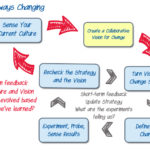Dear Rt. Hon. Kim Campbell, In early October we met in the Toronto airport while lining up to board for Edmonton. I’m the Ottawa-based management consultant, who helps organizations become more effective. You asked what it is that I do, so I’ve undertaken to explain it here briefly, in a way that’s clear regardless of […]
Notes from a Tool User
Agile Change or Adoption: Define Small Organizational Changes
(Continued from Agile Change or Adoption Always Starts with Why : 1 , 2 , 3 , 4 , 5 ) Seeing an organizational change map with seven to eight proposed major changes can feel daunting and discouraging. It’s even worse when we realize that list will keep growing as new organizational problems are discovered. By taking on only one or two changes at a […]
Reinventing Existing Products – Big Bite vs Small Nibble Rewrites
Twice now in my career I’ve done a massive rewrite to replace an existing product. In both cases, it didn’t end well. Each time, the new product was competing with an existing product that was making the company money. So, of course, the existing product got enhancements on a rickety structure, and on the new […]
$50 Million Phoenix Fix – Avoiding Disaster With Scrum
As most Canadians can tell you, the rollout of the Canadian Government’s Phoenix payroll modernization system has gone disastrously badly. At one stage, there were over 80,000 civil servants who had payment problems, with some even losing their houses over the mess. I’ve seen everything from the contractor (IBM) to a lack of training being […]
Measurement for Scrum – What are Appropriate Measures?
We’ve seen the risks of assuming that everything is normal distribution, and also the problem with reporting a single number. What else do we need to be aware of? What can we usefully measure? Risks in Measurement Many important things can’t be measured using formal measurement systems. As a result, not enough attention is paid […]
Forecasting, Metrics and the Lies that a Single Number Tell Us
This post has now been replaced by the updated and expanded Red-Yellow-Green Status Reports and Other Models – How They Should and Shouldn’t Be Used post. Please update all bookmarks and links accordingly. We’ve previously seen that our mental models often make false assumptions due to cognitive bias. Giving a Single number in a report has […]
Agile Change or Adoption: Turn Vision into Strategy
(Continued from Agile Change or Adoption Always Starts with Why : 1 , 2 , 3 , 4 ) We’re already familiar with how Story Maps are an excellent way to help development teams visualize the work involved in building a large product. They act as stepping-stones between the initial vision and the resulting deliverable user stories. But Story Maps can serve a similar purpose […]
Agile Change or Adoption: Create a Vision
(Continued from Agile Change or Adoption Always Starts with Why: Part 1, Part 2, Part 3) Most organizational change effort starts with a vision. But problems arise if the vision was created by a few executives who went off-site, as that can result in a vision that doesn’t address the problems felt by the doers at […]




